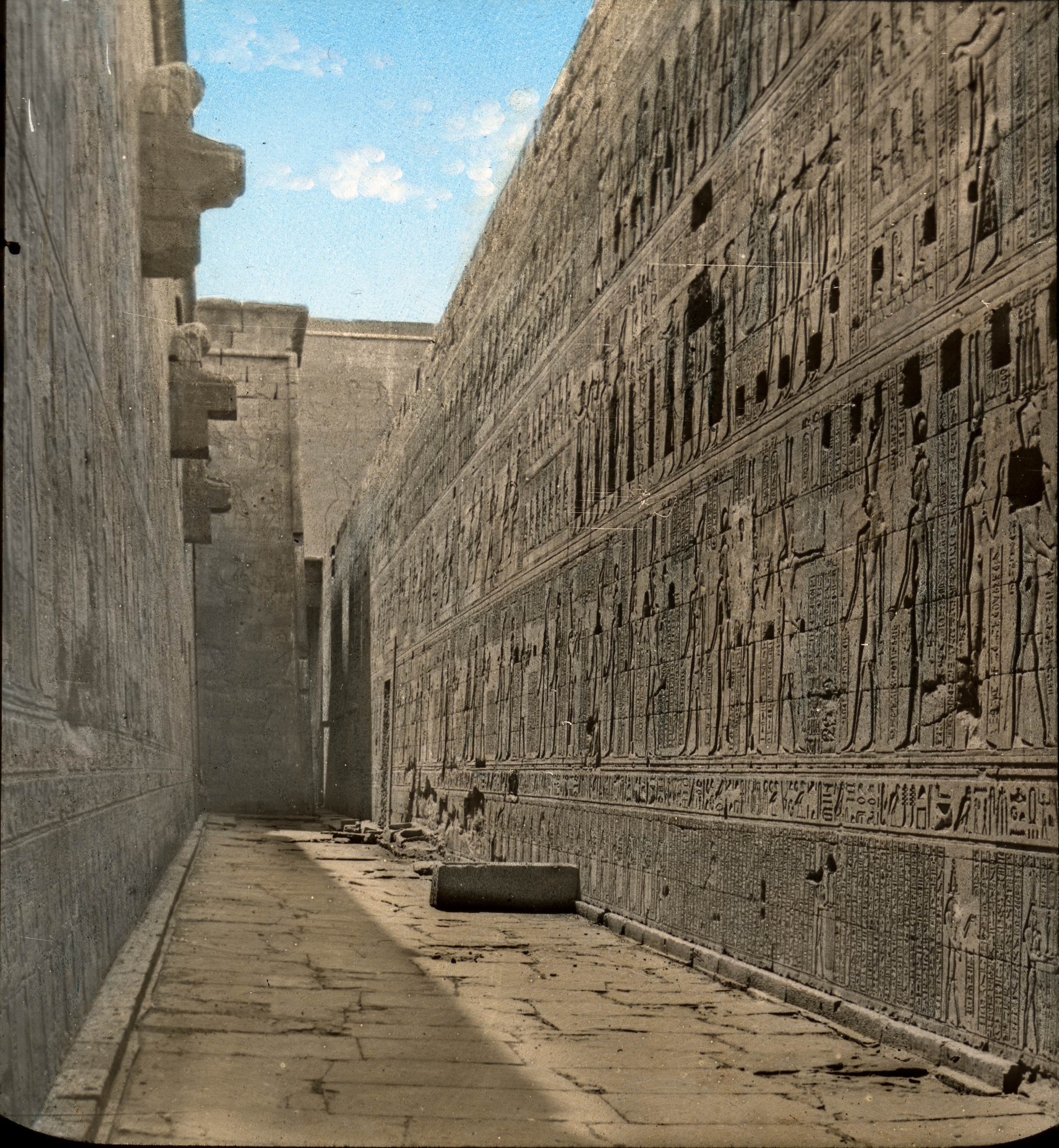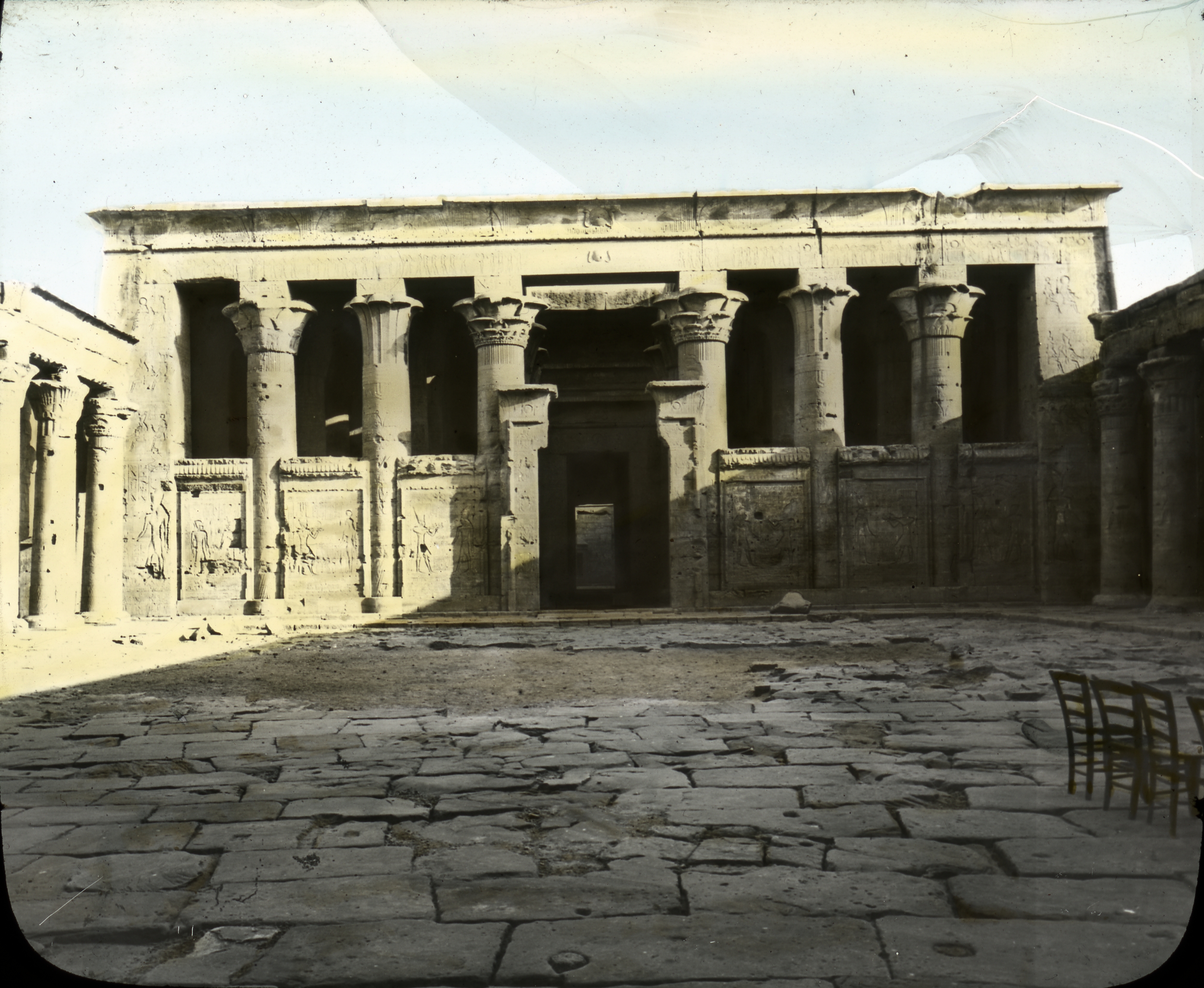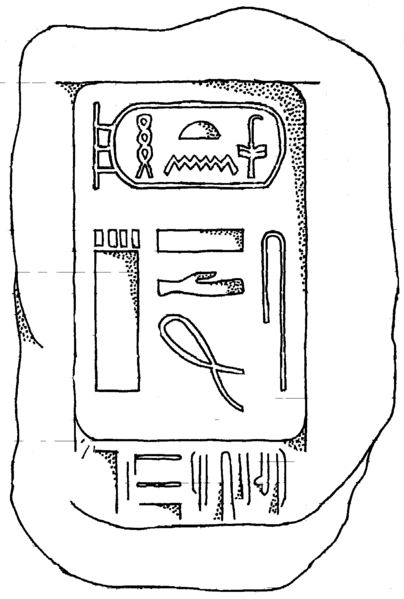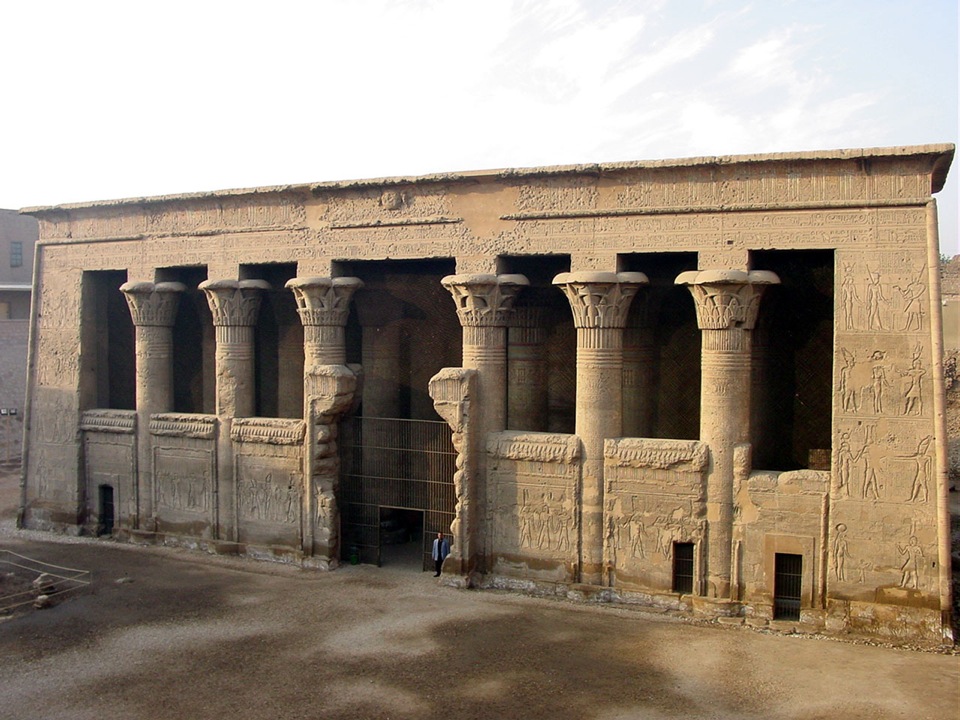|
Edfu
Edfu ( egy, bḥdt, ar, إدفو , ; also spelt Idfu, or in modern French as Edfou) is an Egyptian city, located on the west bank of the Nile River between Esna and Aswan, with a population of approximately sixty thousand people. Edfu is the site of the Ptolemaic Temple of Horus and an ancient settlement, Tell Edfu. About south of Edfu are remains of ancient pyramids. Ancient history Ancient Tell Edfu The remains of the ancient settlement of Edfu are situated about 50 m to the west of the Ptolemaic temple – to the left of the older temple pylon. This settlement is known as ''Wetjeset-hor'' and the Greek name was ''Apollinopolis Magna'' (Ancient Greek: ''Apollinòpolis'', ''Απολλινόπολις''). According to ''Notitia Dignitatum'', part of Legio II ''Traiana Fortis'' was camped in ''Apollo superior'', which was the Roman name for the town. Although unassuming and unglamorous to the visiting tourists, Tell Edfu is a monument that contains evidence of more Egypti ... [...More Info...] [...Related Items...] OR: [Wikipedia] [Google] [Baidu] |
Temple Of Edfu
The Temple of Edfu is an Egyptian temple located on the west bank of the Nile in Edfu, Upper Egypt. The city was known in the Hellenistic period in grc-koi, Ἀπόλλωνος πόλις and in Latin as ''Apollonopolis Magna'', after the chief god Horus, who was identified as Apollo under the ''interpretatio graeca''. It is one of the best preserved shrines in Egypt. The temple was built in the Ptolemaic Kingdom between 237 and 57 BC. The inscriptions on its walls provide important information on language, myth and religion during the Hellenistic period in Egypt. In particular, the Temple's inscribed building texts "provide details othof its construction, and also preserve information about the mythical interpretation of this and all other temples as the Island of Creation." There are also "important scenes and inscriptions of the Sacred Drama which related the age-old conflict between Horus and Seth." They are translated by the Edfu-Project. History Edfu was one of several t ... [...More Info...] [...Related Items...] OR: [Wikipedia] [Google] [Baidu] |
Kazimierz Michałowski
Kazimierz Józef Marian Michałowski (born December 14, 1901 in Tarnopol – January 1, 1981 in Warsaw) was a Polish archaeologist and Egyptologist, art historian, member of the Polish Academy of Sciences, professor ordinarius of the University of Warsaw as well as the founder of the Polish school of Mediterranean archaeology and a precursor of Nubiology. Biography Early life and the beginning of scientific career Kazimierz Michałowski graduated from a gymnasium in Tarnopol and then studied classical archaeology and art history at the Philosophy Department of the Jan Kazimierz University in Lwów; he also attended philosophy lectures by Professor Kazimierz Twardowski. He broadened his knowledge at universities in Berlin, Heidelberg, Paris, Rome and Athens. As a young scientist he took part in excavations managed by École Française d`Athènes in Delphi, Thasos and Delos. In 1926 he defended his doctoral thesis devoted to Niobids in Greek art, which he prepared at the ... [...More Info...] [...Related Items...] OR: [Wikipedia] [Google] [Baidu] |
Horus
Horus or Heru, Hor, Har in Ancient Egyptian, is one of the most significant ancient Egyptian deities who served many functions, most notably as god of kingship and the sky. He was worshipped from at least the late prehistoric Egypt until the Ptolemaic Kingdom and Roman Egypt. Different forms of Horus are recorded in history, and these are treated as distinct gods by Egyptologists."The Oxford Guide: Essential Guide to Egyptian Mythology", Edited by Donald B. Redford, Horus: by Edmund S. Meltzer, pp. 164–168, Berkley, 2003, . These various forms may be different manifestations of the same multi-layered deity in which certain attributes or syncretic relationships are emphasized, not necessarily in opposition but complementary to one another, consistent with how the Ancient Egyptians viewed the multiple facets of reality. He was most often depicted as a falcon, most likely a lanner falcon or peregrine falcon, or as a man with a falcon head. The earliest recorded form of Ho ... [...More Info...] [...Related Items...] OR: [Wikipedia] [Google] [Baidu] |
Pylon (architecture)
A pylon is a monumental gate of an Egyptian temple (Egyptian: ''bxn.t'' in the Manuel de Codage transliterationErmann & Grapow, ''Wörterbuch der ägyptischen Sprache'', vol.1, 471.9–11). The word comes from the Greek language, Greek term 'gate'. It consists of two pyramidal towers, each tapered and surmounted by a cornice, joined by a less elevated section enclosing the entrance between them.Toby Wilkinson, ''The Thames and Hudson Dictionary of Ancient Egypt'', Thames & Hudson, 2005. p.195 The gate was generally about half the height of the towers. Contemporary paintings of pylons show them with long poles flying banners. Egyptian architecture In ancient Egyptian religion, the pylon mirrored the Egyptian hieroglyphs, hieroglyph akhet (hieroglyph and season), ''akhet'' 'horizon', which was a depiction of two hills "between which the sun rose and set". Consequently, it played a critical role in the symbolic architecture of a building associated with the place of re-creation an ... [...More Info...] [...Related Items...] OR: [Wikipedia] [Google] [Baidu] |
Huni
Huni (original reading unknown) was an ancient Egyptian king and the last pharaoh of the Third Dynasty of Egypt during the Old Kingdom period. Following the Turin king list, he is commonly credited with a reign of 24 years, ending c. 2613 BC. Huni's chronological position as the last king of the third dynasty is seen as fairly certain, but there is still some uncertainty on the succession order of rulers at the end of the 3rd dynasty. It is also unclear under which Hellenized name the ancient historian Manetho could have listed him in his historical writing ''Aegyptiacae''. Most possibly he is to be identified with the Hellenized name Aches, as Winfried Barta proposes. Many Egyptologists believe that Huni was the father and direct predecessor of king Sneferu, but this is questioned by other scholars. Huni is seen by scholars as a confusing figure in Egyptian history, because he was long remembered in Egyptian traditions, but very few documents, objects or monuments f ... [...More Info...] [...Related Items...] OR: [Wikipedia] [Google] [Baidu] |
Aswan Governorate
Aswān Governorate (Arabic: محافظة أسوان) is one of the governorates of Egypt. The southernmost governorate in Upper Egypt, covering most of Lake Nasser. The Governorate's capital is Aswan. The Aswan Governorate borders Qena Governorate to the north, Red Sea Governorate to the east, New Valley Governorate to the west, and Sudan's Northern state to the south. It has a population of 1,394,687 inhabitants (2014), and occupies an area of 62,726 km². Overview The rate of poverty is more than 60% in this governorate but recently some social safety networks have been provided in the form of financial assistance and job opportunities. The funding has been coordinated by the country's Ministry of Finance and with assistance from international organizations. Municipal divisions The governorate is divided into the following municipal divisions for administrative purposes with a total estimated population as of July 2017 of 1,481,446. In some instances there is a markaz ... [...More Info...] [...Related Items...] OR: [Wikipedia] [Google] [Baidu] |
Ptolemaic Dynasty
The Ptolemaic dynasty (; grc, Πτολεμαῖοι, ''Ptolemaioi''), sometimes referred to as the Lagid dynasty (Λαγίδαι, ''Lagidae;'' after Ptolemy I's father, Lagus), was a Macedonian Greek royal dynasty which ruled the Ptolemaic Kingdom in Ancient Egypt during the Hellenistic period. Their rule lasted for 275 years, from 305 to 30 BC. The Ptolemaic was the last dynasty of ancient Egypt. Ptolemy, one of the seven somatophylakes (bodyguard companions), a general and possible half-brother of Alexander the Great, was appointed satrap of Egypt after Alexander's death in 323 BC. In 305 BC, he declared himself Pharaoh Ptolemy I, later known as ''Sōter'' "Saviour". The Egyptians soon accepted the Ptolemies as the successors to the pharaohs of independent Egypt. Ptolemy's family ruled Egypt until the Roman conquest of 30 BC. Like the earlier dynasties of ancient Egypt, the Ptolemaic dynasty practiced inbreeding including sibling marriage, but this did not start ... [...More Info...] [...Related Items...] OR: [Wikipedia] [Google] [Baidu] |
Legio II Traiana Fortis
Legio II Traiana, ( Second Legion "Trajan") was a legion of the Imperial Roman army raised by emperor Trajan, along with XXX ''Ulpia Victrix'', for the campaigns in Dacia. Records of the II ''Traiana Fortis'' have been recovered from Egypt dating to the middle of the 5th century. The legion's emblem was the demi-god Hercules. Origins According to Cassius Dio, it was Trajan who raised both the II ''Traiana'' and the XXX ''Ulpia Victrix'', but the details and order is not clear. H.M.D. Parker has argued that the XXX ''Ulpia'' was raised first, at the time there were 29 legions, then after Legio XXI ''Rapax'' vanished—either destroyed in battle against barbarian invaders or in a civil disturbance—the II Traiana came into existence. The date of the legion's creation is also not certain, although Graham Webster assigns it to the year 101. The earliest dated inscription referring to the legion, which lists the posts Lucius Cossonius Gallus held during his career, again ent ... [...More Info...] [...Related Items...] OR: [Wikipedia] [Google] [Baidu] |
Cleopatra VII
Cleopatra VII Philopator ( grc-gre, Κλεοπάτρα Φιλοπάτωρ}, "Cleopatra the father-beloved"; 69 BC10 August 30 BC) was Queen of the Ptolemaic Kingdom of Egypt from 51 to 30 BC, and its last active ruler.She was also a diplomat, naval commander, linguist, and medical author; see and . A member of the Ptolemaic dynasty, she was a descendant of its founder Ptolemy I Soter, a Macedonian Greek general and companion of Alexander the Great. writes about Ptolemy I Soter: "The Ptolemaic dynasty, of which Cleopatra was the last representative, was founded at the end of the fourth century BC. The Ptolemies were not of Egyptian extraction, but stemmed from Ptolemy Soter, a Macedonian Greek in the entourage of Alexander the Great."For additional sources that describe the Ptolemaic dynasty as " Macedonian Greek", please see , , , and . Alternatively, describes them as a "Macedonian, Greek-speaking" dynasty. Other sources such as and describe the Ptolemies as ... [...More Info...] [...Related Items...] OR: [Wikipedia] [Google] [Baidu] |
Esna
Esna ( ar, إسنا , egy, jwny.t or ; cop, or ''Snē'' from ''tꜣ-snt''; grc-koi, Λατόπολις ''Latópolis'' or (''Pólis Látōn'') or (''Lattōn''); Latin: ''Lato''), is a city of Egypt. It is located on the west bank of the Nile some south of Luxor. The town was formerly part of the modern Qena Governorate, but as of 9 December 2009, it was incorporated into the new Luxor Governorate. Latopolis This city of Latopolis (πόλις Λάτων) in the Thebaid of Upper Egypt should not be confused with the more northerly city of Letopolis (Λητοῦς Πόλις), ancient Khem, modern Ausim, in the Nile Delta in Lower Egypt. Ancient city The name "Latopolis" is in honor of the Nile perch, ''Lates niloticus'', the largest of the 52 species which inhabit the Nile, which was abundant in these stretches of the river in ancient times, and which appears in sculptures, among the symbols of the goddess Neith, associated by the ancient Greeks as Pall ... [...More Info...] [...Related Items...] OR: [Wikipedia] [Google] [Baidu] |
Nile River
The Nile, , Bohairic , lg, Kiira , Nobiin: Áman Dawū is a major north-flowing river in northeastern Africa. It flows into the Mediterranean Sea. The Nile is the longest river in Africa and has historically been considered the longest river in the world, though this has been contested by research suggesting that the Amazon River is slightly longer.Amazon Longer Than Nile River, Scientists Say Of the world's major rivers, the Nile is one of the smallest, as measured by annual flow in cubic metres of water. About long, its covers eleven countries: the |
University Of Warsaw
The University of Warsaw ( pl, Uniwersytet Warszawski, la, Universitas Varsoviensis) is a public university in Warsaw, Poland. Established in 1816, it is the largest institution of higher learning in the country offering 37 different fields of study as well as 100 specializations in humanities, technical, and the natural sciences. The University of Warsaw consists of 126 buildings and educational complexes with over 18 faculties: biology, chemistry, journalism and political science, philosophy and sociology, physics, geography and regional studies, geology, history, applied linguistics and philology, Polish language, pedagogy, economics, law and public administration, psychology, applied social sciences, management and mathematics, computer science and mechanics. The University of Warsaw is one of the top Polish universities. It was ranked by ''Media in Poland, Perspektywy'' magazine as best Polish university in 2010, 2011, 2014, and 2016. International rankings such as ARWU an ... [...More Info...] [...Related Items...] OR: [Wikipedia] [Google] [Baidu] |




.jpg)



